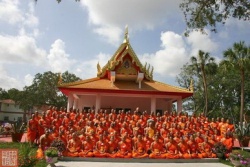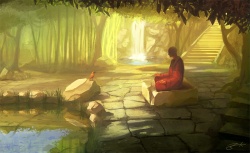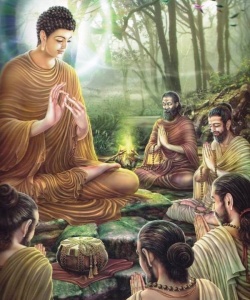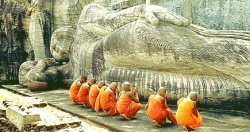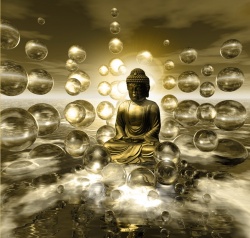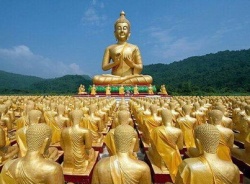Engaged Buddhism in Cambodia: Maha Ghosananda, Dhammayietra for Peace and Nonviolence by Ven. Piseth
Introduction
Cambodia or Kampuchea is a country located in Southeast Asia. It is bordered by Thailand, Laos, Vietnam and the Gulf of Thailand. The official religion in Cambodia is Theravada Buddhism, which is practiced by around 95% of its population. Nowadays, there are many Buddhist monks practicing and studying the teaching of the Buddha (Dhamma and Vinaya) in temples around the country. In my province, Kratie (a province in northeastern Cambodia), has many Buddhist monks studying in Dhamma Vianaya Schools and Buddhist High Schools. There are also a few Buddhist Meditation Centers for all Buddhists to practice meditation too.
During the Khmer Rouge Era, in 1975 when the communist Khmer Rouge took control of Cambodia, Buddhism was nearly completely destroyed. Every monks and religious intellectual had been either murdered or driven into exile and every temple and Buddhist temples and library had been destroyed. The Khmer rouge policies towards Buddhism- which included the forcible disrobing of the monks, the destruction of monasteries, and, ultimately, the execution of uncooperative monks effectively destroyed Cambodia’s Buddhist institutions. Monks who did not flee and avoided execution lived among the laity, sometimes secretly performing Buddhist rituals for the sick or afflicted.[1] Estimates vary regarding the number of monks in Cambodia prior to the ascension of the Khmer Rouge, ranging between 65,000 and 80,000.[2]
By the time of the Buddhist restoration in the early 1980s, the number of Cambodian monks worldwide was estimated to be less than 3,000.4 But at this present time, there are 55,583 monks and novices in [3],307 wats (temple) across the country.[4] Nowadays, Buddhism is the main part of Khmer people to practice and study the Buddha’s teachings.
The Origin of Engaged Buddhism
As we know, engaged Buddhism is originally coined by noted Vietnamese Zen teacher Venerable Thich Nhat Hanh. During the Vietnamese War when he and his Dhamma friends were interested in their meditative practices but the society was afflicted by the suffering of the war so the question arose in their mind regarding the objective of their religious life. They thought that when the other part of society is faced with the fear, pain and suffering so would it be appropriate for them to confine themselves to their spiritual practices, hiding from the external world? After thought, they decided to do their action to society. Because of their spiritual practices so that they could understand the grief and agony of others so they go out of their place to offer their services to common people of the society by helping them with the Buddhadhamma. They gave this way of life as a new Chinese term, translated as Engaged Buddhism into English, although not considered to be very good translation.[5]
If we get understand clearly about this term, Engaged Buddhism might have arisen in the Buddha’s time because this concept already begun with the departure of the Buddha. He taught the Dhamma to many people around India and to show them the path to free from fear, pain and suffering. The Buddha’s service toke forty-five years for people, to teach and to show the path of the Dhamma to people and many of them got enlightenment and live with a great life. The Buddha is a great leader, teacher and a great compassionate person for the world.
Engaged Buddhism in Cambodia
As I mention above, Buddhism was nearly completely destroyed during the Khmer Rouge Era. Monks were forced to disrobe and worked as lay people and some of them were killed. Some monks were exiled to other countries like Vietnam and Thailand…etc. There were many temples destroyed or became the prison. Following the defeat of the Khmer Rouge by forces of the Vietnamese government, Buddhism initially remained officially suppressed within Cambodia.[6] Following challenges to the legitimacy of the Vietnamese-backed People’s Republic of Kampuchea, policies towards Buddhism began to liberalize starting in the summer of 1979.[7] A group of monks who had been exiled and re-ordained in Vietnam during the Khmer Rouge period were sent to Cambodia.[8] Today, Buddhism is struggling to re-establish itself although the lack of Buddhist scholars and leaders and the continuing political instability makes the task difficult.
For Engaged Buddhism in Cambodia, I would like to mention about Venerable Maha Ghosananda because his work, Dhammayietra is the first program that set up for peace and nonviolence in Cambodia. Before I talk about Dhammayietra, I would like to talk a little bit of Maha Ghosananda’s history.
Maha Ghosanada: An Origin Story
Maha Ghosananda, (full title: Samdech Preah Maha Ghosananda), is highly revered Cambodian Buddhist monk in the Theravada tradition, who served as the Patriarch (Sangharaja) of Cambodian Buddhism during the Khmer Rouge period and post-communist transition period of Cambodian history. He was born in Takeo Province, Cambodia in 1929, to a farming family in the Mekong Delta plains. He had interested in religion from his young age and began to serve as a temple boy at age eight and became novice at the age fourteen. He studied Pali and Buddhism in the local temple, and then went to complete his higher education at the Buddhist universities in Phnom Penh and Battambang Province, before going to India to pursue a doctorate in Pali at Nalanda University in Bihar in 1953 and he received doctoral degree as Maha Ghosanada.
While in India for doctoral study, Maha Ghosananda met Nichidatsu Fujii, a Japanese Buddhist whose affiliation with Mahatma Gandhi had inspired him to found the Nipponzan Myohoji, an order dedicated to world peace. It was from Nichidatsu that Maha Ghosananda learned the methods and philosophy of satyagraha (translated as “soul force” or “truth force” that is a particular philosophy and practice within the broader overall category generally known as nonviolence resistance) that was to inform his own nonviolence advocacy in Cambodia.
Maha Ghosananda always traveled and studied that why he became influent in Sangkrit, Pali, Burmese, Vietnamese, Laotian, Thai, French, English and also several Chinese dialects. In 1965, he left Cambodia and journeyed to the isolated forest of Southern Thailand, where he became a disciple of the noted meditation master, Ajahn Dhammasaro. He remained in his Thai forest retreat for more than ten years. After the first flood of refugees began to appear at the Cambodia-Thai border in 1978, Maha Ghosananda left the forest monastery to greet them. He went to Sakeo, the refugee camp for the Khmer Rouge; he walked directly to its center and began to silently distribute pamphlets of the Metta Sutta, the sutta of loving kindness. He said, “All day long we moved the hand up and down” Nonetheless, when troubles with Cambodia were learned, “we cried for Cambodia every day.”[9] As practicing mindfulness meditation, Maha Ghosananda’s inner peace grew and he waited and prayed for a chance to help his people.
Maha Ghosananda moved from meditation master to the refugees’ camp and he was set within the circuits of exile and deterritorialized nation-building. He was known as “The Buddha of the Battlefields”. By 1980, he was the Cambodian nation-in-exile consultant to the U.N. Economic and Social Council and cofounder of the Inter-Religious Mission for Peace in Cambodia. There are two most important precepts of engaged Buddhist interventions is sovereignty battle…nonviolence and neutrality.
Maha Ghosananda returned to Cambodia through the Dhammayietra inspired a rumor that circulated for several years that Ghosananda was the fulfillment of an old prophesy that after the brutal reign of the Thmil (infidels), a “holy man from the west, a light skinned Khmer would appear. A prince would arrive to save his people.”[10] But his efforts to represent a peaceful resolution to conflict in Cambodia have rarely kept him there. In 1992, he received the title as Somdech Phra from King Sihanouk in Phnom Penh and he was known popularly as Somdech Song Santipheap (the Leader of Religion for Peace) in Cambodia.
Maha Ghosananda wrote a book named “Step by Step”, a guide leading to truth, happiness, and peace for all Cambodian as well as for other nations in the whole world if they all follow the eminent path or idea. His famous saying in the book he wrote was “The suffering of Cambodian has been deep, from this suffering come great compassion, great compassion makes a peaceful heart, a peaceful heart makes a peaceful person, a peaceful person makes a peaceful family, a peaceful family makes a peaceful community, a peaceful community makes a peaceful nation, a peaceful nation makes a peaceful world, and may all beings live in happiness and peace in our universe forever”. This book was published in 1993 in many different languages.
Because of his works for Cambodian and for the world, Maha Ghosananda is known as “Buddha of the Battlefield” and “Ghandhi of Cambodia”.
Maha Ghosananda died in Northampton, Massachusetts on March 12, 2007.
Dhammayietra is the Path for Peace and Nonviolence
Dhammayietra means pilgrimage of truth. It is the path of walking on Dhamma to spread peace and happiness to others and Maha Ghosananda set up this program to spread peace around Cambodia. I remember when I was a small temple boy. I saw many villagers line the roads with lustral water (Teuk Mun) and incense that will be plunged into the water to extinguish the fire of war. Often at these times the walk’s iconic leader, Maha Ghosananda reflects upon the Dhammayietra’s purpose, “Peace is growing in Cambodia, slowly, step by step…Each step is a meditation. Each step is a prayer…”[11] This purpose is the most significant of engaged Buddhism in Cambodia because it is the path to get peace for the country.
In 1992, during the first year of the United Nations sponsored peace agreement, Maha Ghosananda led the first nationwide Dhammayatra,[12] a peace march or pilgrimage, across Cambodia in an effort to begin restoring the hope and sprit of the Cambodian people.[13] This Dhammayietra was conceived in the refugee camps at their point of dispersal back into Cambodia. Against the wishes of U.N. bureaucrats preparing to repatriate the 300,000 refugees and government officials of both Cambodia and Thailand, some 350 refugees crossed into Cambodia, “Step by Step.” By the time the walkers reached Phnom Penh, their number had increased to 1,000, snaking through the city.[14]
The second plan for walking Dhammayatra was in 1993 when the volatile conditions preceding the U.N. monitored elections. This time, Dhammayietra took off from Angkor Wat in Siem Reap, the sacred site of Cambodian nationalism in a province in constant tension between the Khmer Rouge and government force. The third Dhammayietra in 1994 proved to be the most controversial. Its itinerary through the war zone in western Cambodia cost the lives of two participants, a monk and a nun, when government soldiers accompanying them and the Khmer Rouge exchanged fire. Maha Ghosananda completed the walk saying “this violence is indeed the reason we walk.” “Our journey for peace begins today and every day. Slowly, slowly, each step is a prayer, each step is a meditation, and each step will build a bridge.”[15]
In May 1995, the fourth Dhammayietra was led by Maha Ghosananda from the Thai border to Svay Rieng near the Vietnamese border. This Dhammayietra focused on banning land mines, to draw attention to the more than 10 million landmines in Cambodia; more mines that people, continue to this day to kill and maim hundreds of farmers and children each year. During the walk, the Buddhist collected 20,000 signatures to ban landmines.
A message from Maha Ghosananda that read by a Unitarian Minister “Peace is always a point of arrival and a point of departure. That is why we must always begin again, step by step, and never get discouraged. Pañña (wisdom) will be our weapon; Mettā (loving kindness) and Karunā (compassion) our bullets; and Sati (mindfulness) our armor. We will walk until Cambodia and the whole world is peaceful.”[16] He also said that, “If a driver is not sober how can he drive a car? If you don’t calm your spirit, you cannot bring peace to the country.”[17]
In 1996, Dhammayiera was held again and it focused on deforestation and the link between militarism, illegal logging and the ongoing civil war. There are seven hundred people took this part through some of the province s most damaged by deforestation. They planted 2,000 trees along the pilgrimage. Maha Ghosananda always gave a public talk to many villagers and encouraged them to “remove the land mines of hatred from our hearts.” He said, “When we respect the environment, then nature will be good to us. The trees are like our mother and father. They feed us and nourish us: provide us with everything- the fruit, the leaves, the branches, the trunk. They give us food and satisfy many of our needs. But if we just cut down the trees it won’t rain anymore. The trees make rain. So on the Dhammayietra we are spreading the Dhamma of protecting ourselves and protecting our environment, which is the Dhamma of the Buddha.”[18]
In 1997, the sixth Dammayietra was a milestone in reconciliation between Khmer Rouge and Government forces, in which Maha Ghosananda urged forgiveness and reconciliation for Khmer Rouge forces who repented and renounced violence. He blessed to Ieng Sary, a senior Khmer Rouge and forgives him and said, “In Buddhism, when people know their crimes and they ask for pardon, then the Buddha pardons them. We do not know if (Ieng Sary) is lying or not, but the Dhamma forgives people who return to the light and give up fighting.”[19] That time was very important task of Maha Ghosananda that he met Khmer Rouge leaders and tough the Dhamma and forgive them. This walk continued for three weeks through all the former strongholds of the defecting Khmer Rouge unites.
Maha Ghosananda offered a message to villagers: “We must remove the landmines in our hearts which prevent us from making peace. The landmines in the heart are greed, hatred and delusion. We can overcome greed with the weapon of generosity; we can overcome hatred with the weapon of loving kindness; we can overcome delusion with the weapon of wisdom. Peace-making starts with us.”[20] Maha Ghosananda gave a simple message which full with a great meaning of the Buddha’s Dhamma.
In May 9, 1998, Maha Ghosananda was awarded the Niwano Peace Prize in a ceremony in Tokyo, Japan. The prize is given to individuals and organizations that have contributed to interreligious cooperation, furthering the cause of world peace. In this year, Maha Ghosananda led two shorter walks in Cambodia. The eighth Dhammayietra was a journey to northeastern Cambodia. This purpose is to protect the environment. And other one was walking from Takeo to the King’s Palace in Phnom Penh. Its purpose to encourage a nonviolent election. After 1998, Maha Ghosananda no longer to part in the Dhammayietra walk because of his failing health.
Dhammayietra takes total times of 7 years from 1992 to 1998 and took a total distance of more than 1 million kilometers.
Conclusion
Engaged Buddhism is a really Buddhist social work to help people to be free from suffering, painful and difficulties in their lives. It is the path to apply Buddhadhamma to society to get peace for oneself and others. Many Buddhist monks working as president of organization, association to help their children, people, society and country by the Dhamma and to continue apply Dhamma to around the world.
In Cambodia, Dhammayietra is the first engaged Buddhism to find peace for the country. The Dhammayietra and Maha Ghosananda are arbiters of exile and international politics. Represented as a quintessential Khmer Buddhist response to Cambodia’s entrenched conflict, the Dhammayietra forget its discursive identity vis a vis the “local” space of the nation but this local space is mobile.
Maha Ghosananda’s instruction to move “step by step” toward peace re-appropriate dangerous mobility- the massive relocation during the Khmer Rouge era, refugee flight, the danger of treading on land fed with mines and turns walking into a mindful act.
Walking step by step with mindfulness is the path to get Peace.
Bibliography
- Chandler, D. 1991. The tragedy of Cambodian history. Politics, war, and revolution since 1945. New Haven, CT: Yale University Press.
- Ebihara, M. 1971, Svay, a Khmer village in Cambodia. Ph.D. dissertation. New York: Columbia University.
- Eppsteiner, F., ed. 1988. The path of compassion: Writing on socially engaged Buddhism. Berkeley, CA: Parallax Press.
- French, L. 1994. Enduring Holocaust, surviving history: Displaced Cambodians on the Thai-Cambodian border, 1989-1991. Ph.D. dissertation, Harvard University.
- Ghosananda, M. 1992. Step by Step. Berkeley, CA: Parallax Press.
- Jackson, K. D. 1989. The ideology of total revolution. In Cambodia 1975-1978: Rendezvous with death, edited by K. Jackson. Princeton, NJ: Princeton University Press.
- Mahoney, J.S. and P. Edmonds, eds. 1992. Editor’s introduction. In Step by Step, by M. Ghosananda. Berkeley, CA: Parallax Press.
- Moser-Puangsuwan, Y. 2000a. One million kilometers for peace, reconciliation and hope: The Dhammayietra movement in Cambodia. In Nonviolence intervention across borders: A recurrent vision, edited by Y. Moser-Puangsuwan and T.Weber, pp. 251-68. Honolulu, HI: University of Hawai’i.
- Yang, S. 1987. Khmer Buddhism and politics from 1954 to 1984. Newington, CT: Khmer Studies Institute.
- Sivaraksa, M. 1997. In the shade of the Bodhi tree. Dhammayietra and the re-awakening of community in Cambodia. Crossroads 10 (1): 1032.
- Queen, C. and S. King, eds. 1996. Engaged Buddhists: Buddhist liberation movements in Southeast Asia. Albany, NY: State University of New York Press.
- Venerable Santi, Somdech Preah Maha Ghosananda, The Buddha of the Battlefields, April 1, 2007
Footnotes
- ↑ Harris 2001, p. 74
- ↑ Rajavaramuni 1984, pp. 78-82
- ↑ Hariss 2001, p. 84
- ↑ Min Khin interviewed on Phnom Penh Post, December 18, 2008 http://webcache.googleusercontent.com/search?q=cache:yGidGs049AMJ:www.templenews.org/news/articles/17monks.htm+How+many+monks+in+Cambodia+now%3F&cd=3&hl=en&ct=clnk&gl=th
- ↑ Singh, Dr. Siddharth, Engaged Buddhism in India and Role of Theravada Buddhism: Perspective and Prospects, Theravada Buddhism: Origin, Identity and Development, Conference Volume, Sitagu International Buddhist Academy, Sagaing, Myanmar, 2009
- ↑ Harris 2001, p. 74
- ↑ Ibid, p. 75
- ↑ Ibid, p. 93
- ↑ Mahoney and Edmonds 1992:16
- ↑ Conservation with Bob Maat, November 13, 1994
- ↑ Ghosananda 1992:65
- ↑ Somdech Phra Maha Ghosananda, 1992, http://www.buddhanet.net/masters/maha-gosanada.htm
- ↑ Venerable Santi, Somdech Preah Maha Ghosananda- The Buddha of the Battlefields http://www.ghosananda.org/bio_book.html
- ↑ Moser-Puangsuwan 2000a
- ↑ Venerable Santi, Somdech Preah Maha Ghosananda- The Buddha of the Battlefields, p. 37
- ↑ Ibid , p. 44
- ↑ Ibid, p. 45
- ↑ Ibid, p 46
- ↑ Ibid, p. 48
- ↑ Alan Channer, For a Change, June-July 1997
Source
Author: Ven. Piseth
buddhismandaustralia.com
